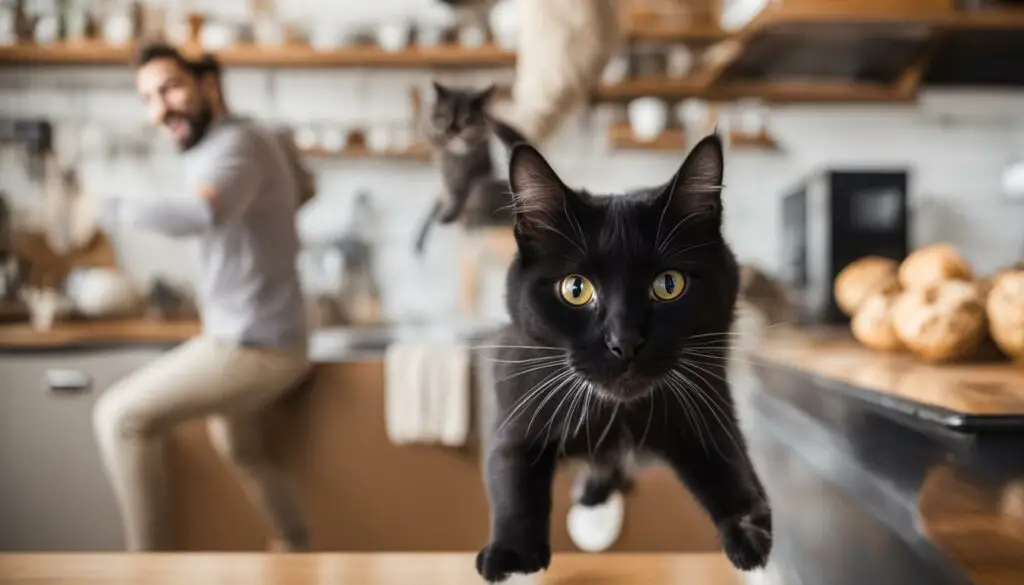Welcome to my guide on keeping cats off kitchen counters! This is an essential task for cat owners who want to ensure their feline friends’ safety and maintain a hygienic environment in the kitchen. Cats jumping on the counters can pose risks such as burns, ingestion of toxic substances, and the spread of bacteria. But don’t worry, I’m here to provide you with practical strategies to redirect your cat’s behavior and prevent them from accessing the countertops.
Key Takeaways:
- Understanding why cats jump on counters helps in implementing effective counter-training strategies.
- Textured coverings like foil, tape, and sandpaper can deter cats from jumping on counters.
- Noise and startling sounds can startle cats away from the counters.
- Scents such as peppermint, citrus, lavender, eucalyptus, and lime are disliked by cats and can be used to deter them.
- Properly storing food and addressing faucet temptations can reduce cats‘ desire to jump on counters.
Why Cats Jump on Counters and the Risks Involved
Understanding the reasons why cats jump on counters is crucial in preventing this behavior and ensuring a safe and hygienic kitchen environment. Cats have a natural inclination for climbing and exploring, and kitchen counters provide an ideal vantage point for them. However, allowing cats on the counters can pose serious risks to their well-being and the overall household.
One of the main hazards of cats jumping on counters is the potential for burns. Countertops often contain hot surfaces, such as stovetops or ovens, which can result in severe injuries if a cat accidentally steps on them. Ingestion of toxic foods or cleaning chemicals is another concern, as many kitchen items can be harmful or even fatal to cats if consumed. Additionally, cats can carry bacteria from their paws onto the counters, increasing the risk of food contamination and potential illness for humans.
Preventing cats from accessing kitchen counters is essential for their safety. By implementing effective counter-training strategies and understanding the underlying motivations for this behavior, it is possible to discourage cats from jumping on counters and create a safer environment for both cats and their owners.
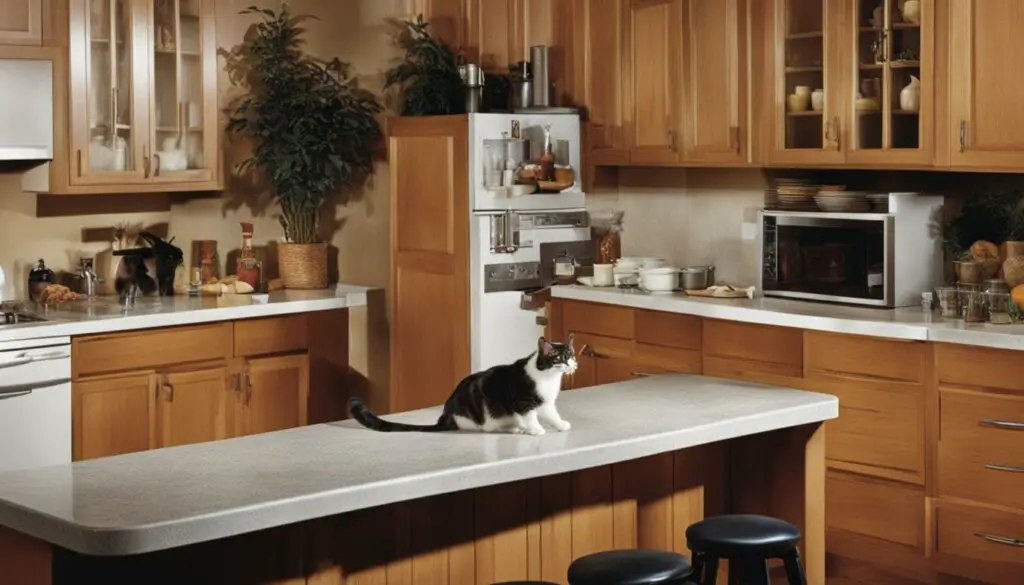
Table: Risks of Cats Jumping on Counters
| Risks | Description |
|---|---|
| Burns | Cats can accidentally step on hot surfaces, such as stovetops or ovens, leading to severe burns or injuries. |
| Ingestion of toxins | Kitchen counters may contain toxic foods or cleaning chemicals that can be harmful or fatal if ingested by cats. |
| Bacterial contamination | Cats can carry bacteria from their paws onto the counters, increasing the risk of food contamination and potential illness for humans. |
Implementing strategies such as covering the counters with foil or other textured materials, creating startling sounds, and using scents that cats dislike can help deter them from jumping on the counters. Additionally, storing food properly, addressing faucet temptations, and providing alternative climbing areas like cat towers can redirect their behavior towards more appropriate spaces. Positive reinforcement techniques, such as clicker training, can also be effective in teaching cats to stay off counters.
By understanding the risks involved and implementing preventive measures, cat owners can create a kitchen environment that is safe, hygienic, and free from the potential dangers associated with cats jumping on counters.
Using Foil and Other Textured Coverings
One effective method to cat-proof kitchen counters is by using foil and other textured coverings. Cats have a strong aversion to certain materials, and utilizing these textures can deter them from jumping on the counters. One popular choice is aluminum foil, which cats dislike due to its crinkly texture and sound. By covering the entire counter with foil, you create an unpleasant walking surface that discourages cats from accessing the area.
In addition to foil, there are other textured materials that can be used as a deterrent. Double-sided tape, for example, can be applied to the edges of the counter to create an uncomfortable sticky surface for cats. They will quickly learn to avoid walking on the tape. Another option is plastic wrap, which can be stretched tightly across the counter to create an unstable surface. Cats dislike the feeling of their paws sinking into the plastic wrap, making it an effective deterrent.
Similarly, sandpaper can be used as a textured covering. By securing sandpaper to a wooden board or placemat, you create a rough walking surface that cats find uncomfortable. The abrasive texture discourages them from walking on the counter, redirecting their behavior to more suitable areas. It is important to note that these coverings should be consistently applied for a period of time to reinforce the message and discourage cats from accessing the counters.
| Covering Material | Effectiveness | Advantages |
|---|---|---|
| Aluminum Foil | High | Crinkly texture and sound |
| Double-sided Tape | Medium | Sticky surface |
| Plastic Wrap | Medium | Unstable surface |
| Sandpaper | Low | Abrasive texture |
Implementing foil and other textured coverings can be an effective strategy in cat-proofing your kitchen counters. These materials create an uncomfortable and undesirable environment for cats, discouraging them from jumping on the counters. Using these methods in combination with positive reinforcement training can help redirect your cat’s behavior and create a harmonious living space for both you and your feline companion.
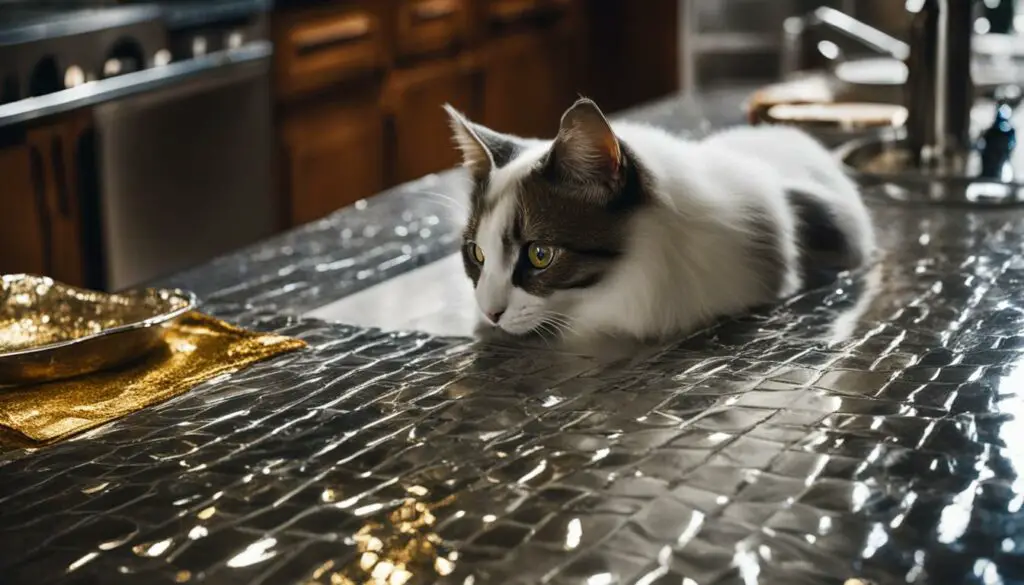
Methods to Stop Cats from Getting on Counters
When it comes to cat-proofing kitchen counters, there are several effective methods that can help deter cats from jumping on them. Understanding these strategies and implementing them consistently can create a safe and hygienic environment in your kitchen. Let’s explore some of the most successful methods to keep cats off counters.
Making Noise and Startling Sounds
Cats can be easily startled by loud or sudden sounds, which can discourage them from jumping on the counters. One effective method is to crinkle aluminum foil and place it strategically on the counters. The noise and texture of the foil will startle the cats and make them associate the counter with an unpleasant experience. Additionally, you can stack lightweight items on the edge of the counter so that they make noise if the cat tries to jump on them. Another option is using an air horn, which can create a loud and startling sound that will make the cats think twice before attempting to climb up.
Utilizing Scents Cats Dislike
Cats have a strong sense of smell and there are certain scents they dislike. You can use this knowledge to your advantage by incorporating these scents into your counter-training efforts. Essential oils such as peppermint, citrus, lavender, eucalyptus, and lime are known to repel cats. Simply apply a few drops of these oils around the perimeter of the counter or on a cloth near the area. The scent will deter the cats from jumping on the counter, creating a natural barrier against their unwanted behavior.
| Methods | Description |
|---|---|
| Making Noise and Startling Sounds | Crinkling aluminum foil or using an air horn can startle cats away from the counters. |
| Utilizing Scents Cats Dislike | Applying essential oils such as peppermint, citrus, lavender, eucalyptus, and lime can deter cats from jumping on the counters. |
Providing an Entertaining Cat Tower
Cats have a natural instinct to climb and explore their surroundings. By providing them with a dedicated climbing and play area, such as a cat tower or climbing tree, you can redirect their attention away from the counters. These structures offer a high vantage point and provide an alternative space for cats to climb, scratch, and explore. By meeting their natural needs with an appealing alternative, you can decrease their desire to access the counters.
By incorporating these methods into your counter-training routine, you can effectively discourage cats from jumping on counters and create a harmonious kitchen environment for both humans and feline friends.
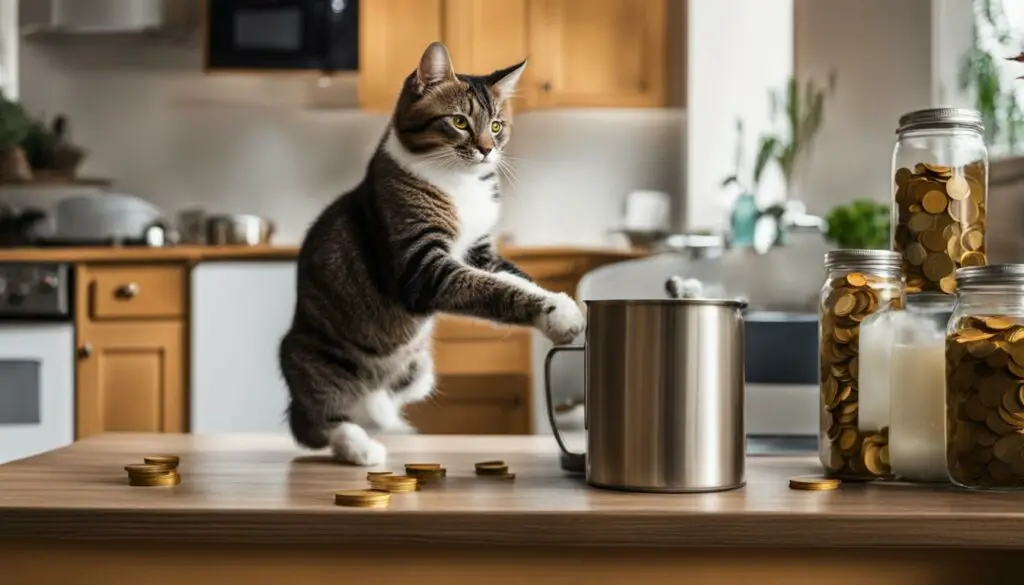
Utilizing Scents Cats Dislike
When it comes to keeping cats away from kitchen counters, incorporating scents that cats dislike can be an effective deterrent. Cats have a strong sense of smell, and certain scents can discourage them from jumping on the countertops. Essential oils such as peppermint, citrus, lavender, eucalyptus, and lime are disliked by cats and can be used to create an environment that they find unpleasant.
To utilize these scents, you can dilute a few drops of the essential oil of your choice in water and spray it on the countertops. Make sure to avoid direct contact with the cat or ingestion of the oils. Additionally, you can soak cotton balls in the essential oil and place them strategically around the kitchen to create a scent barrier. Cats will find these scents off-putting and will be less likely to venture onto the countertops.
It’s important to note that while these scents can be effective in deterring cats, individual cat preferences may vary. Some cats may be more sensitive to certain scents than others, so it may require some trial and error to find the scents that work best for your cat.
| Scents | Description |
|---|---|
| Peppermint | The strong scent of peppermint is disliked by cats and can help deter them from countertops. |
| Citrus | Scents like lemon, orange, and grapefruit are not favored by cats and can be used to discourage countertop jumping. |
| Lavender | Lavender has a calming effect on humans but is disliked by cats, making it an effective scent to deter them from countertops. |
| Eucalyptus | The strong aroma of eucalyptus is disliked by cats and can help discourage them from accessing the countertops. |
| Lime | The scent of lime is disliked by cats and can be used as a natural deterrent to stop them from jumping on the countertops. |
By utilizing scents that cats dislike, you can create an environment that cats find unappealing, and they will be less inclined to jump on the kitchen countertops. It’s essential to ensure the safety of both your cat and yourself when using essential oils, so always follow proper dilution and application guidelines. With consistency and persistence, you can successfully discourage your furry friend from countertop jumping and maintain a clean and hygienic kitchen space.

Cat-Proofing Kitchen Counters: Tips for Keeping Cats Off Countertops
When it comes to keeping cats off kitchen counters, there are several simple yet effective measures you can take. By implementing these tips, you can create a cat-proof environment and prevent your furry friend from accessing the countertops.
1. Clear the counters:
Keep your counters free from any items that may tempt your cat, such as food, dirty dishes, or crumbs. Clearing the counters of enticing objects will eliminate their motivation to jump up in the first place.
2. Use deterrents:
There are various cat deterrents available that can discourage cats from jumping on countertops. For example, you can use double-sided tape or sticky mats on the edges of the counters, as cats dislike the texture. Additionally, you can place motion-activated alarms or deterrent sprays near the counters to startle the cat when they approach.
3. Provide alternative surfaces:
Cats love to be up high, so providing alternative elevated surfaces can redirect their climbing instincts. Consider investing in a cat tree or shelves specifically designed for cats. These provide them with a designated space to climb and perch, reducing their desire to access the kitchen counters.
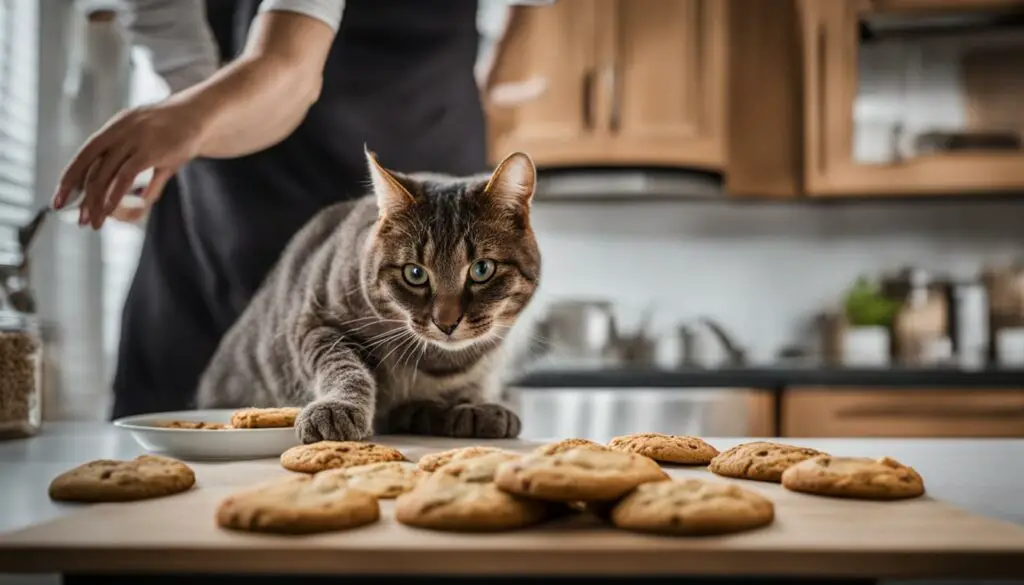
In conclusion, cat-proofing your kitchen counters is possible by implementing a few simple techniques. By clearing the counters, using deterrents, and providing alternative surfaces, you can create an environment that discourages your cat from jumping onto the countertops. Remember, consistency is key. With patience and persistence, you can successfully train your cat to stay off the counters and maintain a clean and safe kitchen for both you and your feline companion.
Addressing Faucet Temptations
Cats are naturally curious creatures, and the sound of running water from a faucet can be irresistibly tempting to them. To prevent cats from jumping on your kitchen counters in search of fresh flowing water, it’s essential to address their faucet temptations. Here are some strategies to help you cat-proof your kitchen counters and redirect their attention.
Fix Leaks and Optimize the Water Bowl Location
One of the reasons cats may be drawn to the kitchen faucet is because they’re seeking a source of running water. It’s important to fix any leaks in your faucets to eliminate this allure. Additionally, make sure your cat has easy access to a water bowl by placing it in a convenient and appealing location. Cats prefer fresh, flowing water, so consider investing in a cat fountain to satisfy their need for running water and divert their attention from the faucet.
Provide an Alternative Source of Fresh Flowing Water
Cats are less likely to jump on kitchen counters if they have another option for accessing fresh flowing water. A cat fountain not only provides a constant stream of water but also keeps it filtered and oxygenated, which is healthier for your feline friend. Set up the cat fountain near the kitchen counter to provide an attractive and accessible alternative for your cat to quench their thirst.
| Strategies to Address Faucet Temptations | Effectiveness |
|---|---|
| Fixing leaks in faucets | High |
| Optimizing water bowl location | Moderate |
| Providing a cat fountain | High |
By implementing these strategies and addressing your cat’s faucet temptations, you can train them to stay off the kitchen counters. Remember to provide positive reinforcement and praise your cat when they choose the alternative water source over the faucet. With consistency and patience, you can create a cat-proof kitchen that keeps your countertops off-limits and your feline companion happy and engaged.
Rearranging Furniture and Blocking Sun Rays
One effective way to prevent cats from jumping on kitchen counters is by rearranging the furniture and blocking sun rays. Cats often use chairs or stools as a stepping stone to reach the counters, so by moving the furniture away from the counters, we disrupt their jumping routine and make it more difficult for them to access the counters. This simple adjustment can discourage cats from attempting to jump on the counters in the first place.

In addition to rearranging furniture, blocking sun rays can also make the counters less appealing for cats. Cats are known to seek warmth, and kitchen counters near windows provide comfortable sunspots. By closing the blinds or curtains, we remove the allure of the warm sun rays, reducing their desire to jump on the counters. This combination of rearranging furniture and blocking sun rays can effectively discourage cats from accessing the kitchen counters.
Avoiding Hazards and Promoting Safety
Aside from the goal of preventing cats from jumping on counters, rearranging furniture and blocking sun rays also contribute to promoting safety. When cats jump on counters, they may knock over objects, potentially causing injuries or accidents. By moving the furniture away from the counters, we minimize the risk of objects falling and harming the cat or other individuals in the kitchen. Additionally, blocking sun rays can prevent cats from accidentally knocking over items near windows while seeking warmth, ensuring a safer environment for everyone.
Overall, rearranging furniture and blocking sun rays are practical methods to keep cats away from kitchen counters. These measures not only discourage cats from attempting to jump on the counters but also promote a safer and more organized kitchen environment. By implementing these strategies consistently, we can create a cat-friendly space while maintaining the hygiene and safety of our countertops.
Providing an Entertaining Cat Tower
Creating an engaging and stimulating environment for your cat is crucial when it comes to training them to stay off the counters. One effective way to redirect their natural instinct to climb is by providing an entertaining cat tower. This dedicated space offers a high vantage point that cats enjoy, satisfying their desire to be elevated.
With a cat tower, your feline companion can engage in climbing, scratching, and exploring, diverting their attention from the counters. It serves as a suitable alternative to the kitchen counters, allowing them to fulfill their natural climbing behavior without posing any risks to their safety or the cleanliness of your kitchen.
When choosing a cat tower, consider the size and layout of your living space, as well as your cat’s preferences. Look for a sturdy structure that provides different levels and platforms for climbing and perching. Scratching posts, dangling toys, and cozy hideaways can further entice your cat to explore and play on the tower.
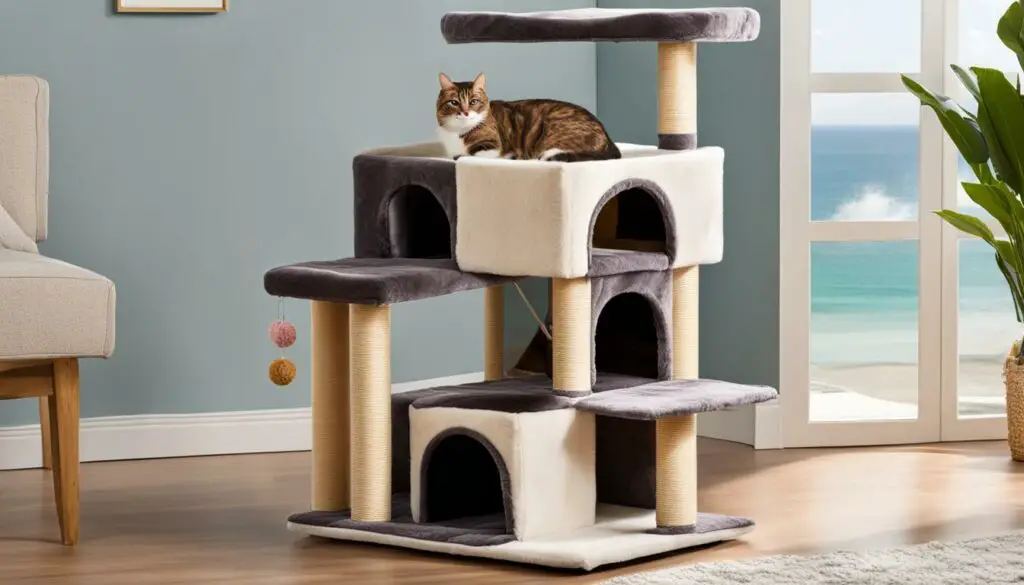
Introduce the cat tower gradually and make it an appealing and inviting space for your cat. Place it in an area that they frequent, preferably near a window or in a room where they spend a lot of time. Encourage your cat to explore and interact with the tower by using treats and toys to create positive associations.
By providing an entertaining cat tower, you not only give your cat an outlet for their natural climbing behavior but also help them stay off the kitchen counters. With time and consistency, they will learn to prefer their designated space over the counters, creating a harmonious living environment for both you and your feline friend.
Using Positive Reinforcement
When it comes to training cats to stay off counters, positive reinforcement is an effective approach. This involves using rewards to encourage desired behaviors and discouraging unwanted behaviors without punishment or fear. One method that can be employed is clicker training. With clicker training, a clicker device is paired with rewards like treats or toys. When the cat jumps off the counter, you can use the clicker to make a distinct sound, followed by giving the cat a reward. Over time, the clicking sound alone will signal to the cat that they should move away from the counters.
It is important to note that consistency is key when using positive reinforcement. It’s essential to consistently use the clicker and rewards every time the cat moves away from the counter. This will help the cat understand that their action of leaving the counter is what leads to the reward. Additionally, it’s essential to provide alternative areas or surfaces where the cat is allowed to climb or explore. This will redirect their natural instinct to climb and help them understand what areas are appropriate for their behavior.
It’s important to avoid negative reinforcement techniques like spraying water or pushing the cat off the counter. These methods can create stress for the cat and may escalate the problem rather than resolving it. Positive reinforcement, on the other hand, helps create a positive association and helps the cat understand what behaviors are desirable. By consistently using positive reinforcement techniques, you can effectively train your cat to stay off counters and create a safe and harmonious environment in your kitchen.
Remember, every cat is unique, and the process of training them to stay off counters may take time and patience. It’s important to be consistent, provide clear cues, and reward desired behaviors to achieve the best results. Using positive reinforcement not only helps keep your counters clean and safe but also strengthens the bond between you and your feline companion.
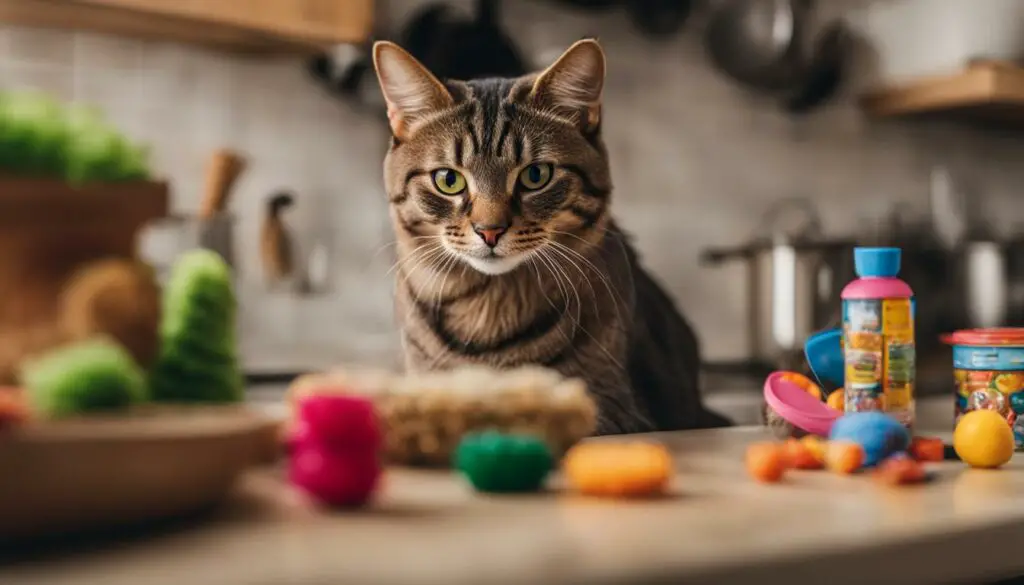
Additional Tips for Using Positive Reinforcement:
- Use high-value treats or toys as rewards to increase the motivation for the cat.
- Start training sessions when the cat is relaxed and receptive.
- Break down the training into small, achievable steps to prevent overwhelming the cat.
- Be patient and consistent, as it may take time for the cat to learn and adapt to new behaviors.
- Gradually reduce the frequency of treats as the cat becomes more consistent in staying off the counters.
Understanding the Reasons Behind the Behavior
Cats have various motivations for jumping on kitchen counters. By understanding these reasons, we can implement targeted strategies to prevent this behavior. Here are some common factors that drive cats to counter-jumping:
- Height and observation: Cats are naturally curious and enjoy having a vantage point to observe their surroundings. The counter offers an elevated position that allows them to keep an eye on what’s happening in the kitchen.
- Aroma of food: The enticing smell of food on the counter can be a strong incentive for cats to explore and potentially find something to nibble on. The scent can be irresistible to their keen sense of smell.
- Warmth and comfort: Countertops near windowsills often provide a cozy spot where cats can bask in the sun’s warmth. This appealing combination of a soft surface and comforting heat can make the counter an attractive resting place.
- Access to fresh running water: Cats are also drawn to kitchen counters because they can find access to fresh running water from the faucet. The sensory experience of flowing water can be captivating for them.
By acknowledging and addressing these motivations, we can develop effective counter-training techniques that cater to cats’ needs and redirect their behavior.
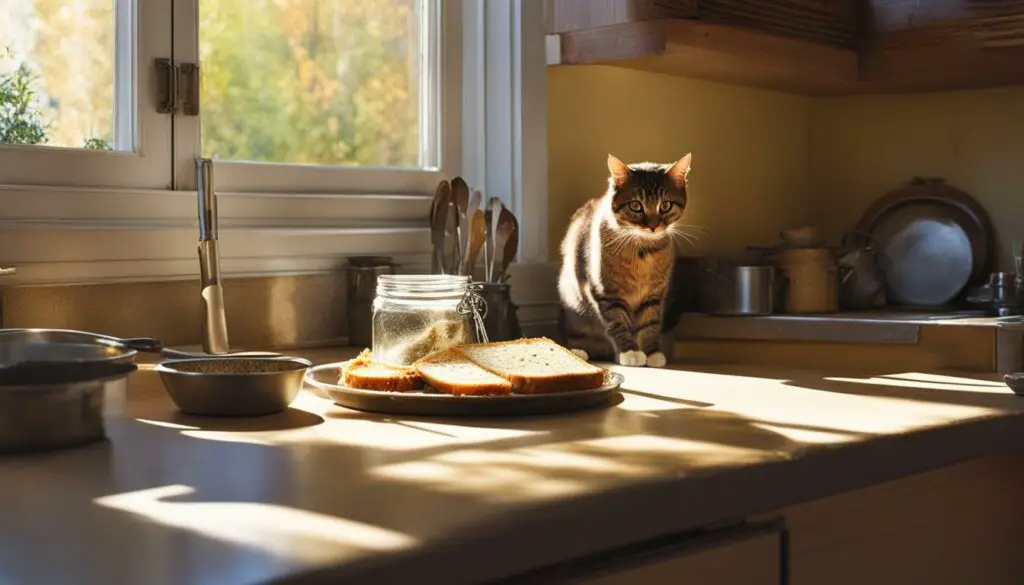
Other Preventive Measures
In addition to the strategies mentioned above, there are other preventive measures that can be taken to deter cats from countertops and keep them away from kitchen counters. These additional techniques can further reinforce the message that jumping on counters is undesirable behavior for cats.
Table:
Here is a table summarizing the other preventive measures:
| Preventive Measure | Description |
|---|---|
| Maintaining a clean counter | Regularly cleaning the counter and ensuring there are no food or crumbs left behind can eliminate the cat’s incentive to jump on it. |
| Providing toys and interactive play options | Offering engaging toys and interactive play options on the ground level can keep cats entertained and distracted from the counters. |
By addressing the underlying reasons for counter-jumping and providing suitable alternatives, such as toys and a clean counter, the behavior can be effectively discouraged. It is important to remember that consistency and persistence are key in maintaining counter-training success.
Seeking Professional Help
If all attempts to keep cats off the counters fail, it may be necessary to seek assistance from a feline behavioral therapist. These professionals can assess the situation, identify any underlying issues, and provide customized behavior modification techniques to address the problem. A trained expert can offer guidance and support to help cats break the habit of jumping on counters.
Working with a feline behavioral therapist can be beneficial in cases where cats consistently ignore or resist counter-training methods. These experts have in-depth knowledge of feline behavior and can tailor a plan that suits the specific needs of your cat. They can analyze the root causes behind the behavior and identify any underlying medical or psychological issues that may be contributing to it.
Implementing behavior modification techniques under the guidance of a professional is crucial to ensure the well-being of your cat. They can provide personalized strategies and techniques that focus on positive reinforcement and redirecting your cat’s behavior to more appropriate areas. By addressing the root causes and providing suitable alternatives, a feline behavioral therapist can help your cat overcome their counter-jumping habit.
Remember to maintain open communication with the feline behavioral therapist throughout the process. They can provide ongoing support and guidance, adjusting the training plan as needed. With their expertise and your commitment, you can effectively train your cat to stay off the counters and create a harmonious environment in your home.
Cat-Proofing Kitchen Counters: Effective Methods to Stop Cats from Getting On Counters
Keeping cats off kitchen counters can be challenging, but with consistent effort and the right strategies, it is possible to deter them from this behavior. Here are some effective methods for cat-proofing kitchen counters:
- Using textured coverings: Cats dislike the feel and sound of materials like aluminum foil or double-sided tape. By covering the counters with these deterrents, you can make the surface unappealing for your feline friends.
- Making noise and startling sounds: Cats can be sensitive to loud or sudden sounds. Use crinkling aluminum foil, lightweight items that make noise when knocked over, or an air horn to startle them away from the counters.
- Utilizing scents cats dislike: Certain scents, such as peppermint, citrus, lavender, eucalyptus, and lime, are disliked by cats. Spraying these scents in the kitchen can help deter them from the counters.
Additionally, it is essential to store food properly, address faucet temptations, rearrange furniture, provide an entertaining cat tower, and use positive reinforcement for effective counter training. These methods, combined with consistency and persistence, will teach your cats to associate the counters with negative experiences and opt for alternative areas to explore and rest.
Remember, cat-proofing kitchen counters requires patience and a deep understanding of your cat’s behavior. By implementing these strategies and providing suitable alternatives, you can create a safe and hygienic kitchen environment for both you and your feline companions.
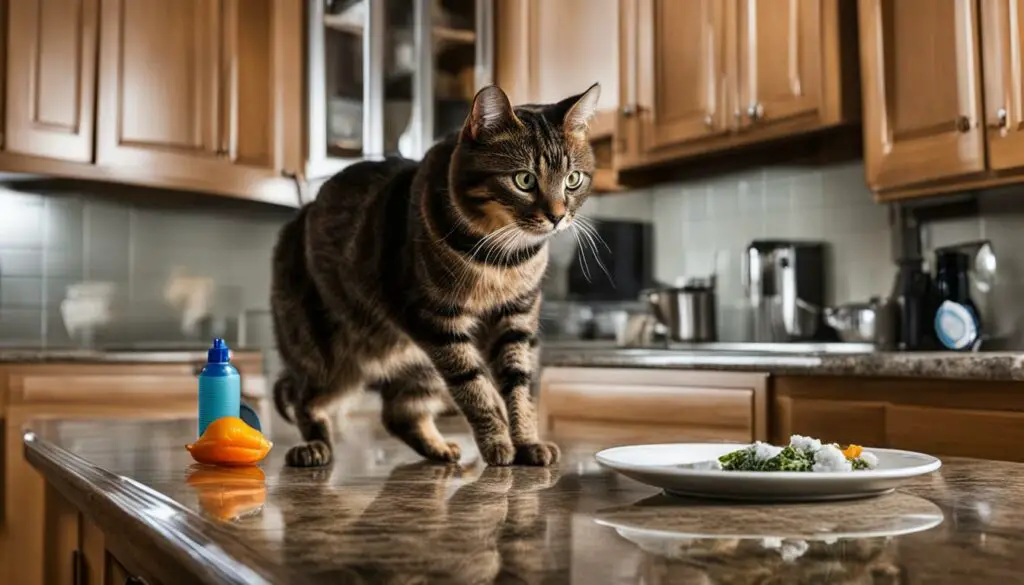
Conclusion
After thoroughly exploring the various strategies to keep cats off kitchen counters, I hope you now have a comprehensive understanding of how to cat-proof your space and train your furry friend to stay off the counters. Remember that consistency and patience are key in successfully implementing these techniques.
By combining deterrents such as textured coverings, startling sounds, and scents cats dislike, along with positive reinforcement training methods, you can create a safe and hygienic kitchen environment for both you and your cat.
Always keep in mind the reasons behind your cat’s counter-jumping behavior and address their needs accordingly. Providing alternative climbing and play areas, ensuring proper food storage, and diverting their attention from faucets and sun rays are essential steps in cat-proofing your kitchen counters.
With persistence and a deep understanding of your cat’s behavior, you can create a harmonious environment where counters are off-limits, allowing you to maintain a clean and safe space while enjoying a strong bond with your feline companion.
FAQ
Why do cats jump on counters?
Cats are naturally inclined to jump and climb, and kitchen counters provide an elevated vantage point for them to observe their surroundings.
What are the risks of cats jumping on counters?
Cats jumping on counters can lead to burns from hot surfaces, ingestion of toxic substances, and the spread of bacteria that can make the family sick.
How can I deter cats from jumping on counters?
There are several strategies you can try, such as covering the counters with aluminum foil or other textured materials, creating startling noises, utilizing scents cats dislike, storing food properly, addressing faucet temptations, rearranging furniture, providing an entertaining cat tower, using positive reinforcement, understanding the reasons behind the behavior, implementing other preventive measures, or seeking professional help.
Can I use aluminum foil to keep cats off counters?
Yes, covering the counters with aluminum foil or other textured materials can deter cats from jumping on them. Cats dislike the feel and sound of foil, making it an effective deterrent.
How can I startle cats away from the counters?
You can try crinkling aluminum foil, stacking lightweight items that make noise when knocked over, or using an air horn to startle cats away from the counters. The key is to create a sound that surprises the cats and makes them associate the counter with an unpleasant experience.
What scents do cats dislike?
Cats dislike scents such as peppermint, citrus, lavender, eucalyptus, and lime. These scents can be used to deter them from jumping on the counters.
How should I store food to prevent cats from jumping on counters?
It is essential to store food securely, seal bagged food tightly, and keep dishes washed to prevent any lingering scent of food on the counters. Removing food temptations and maintaining a clean kitchen counter will discourage cats from trying to access the countertops.
How can I address faucet temptations?
Fixing leaks and checking the water bowl location can help satisfy a cat’s need for running water. Providing an alternative source of fresh flowing water, such as a cat fountain, can divert their attention from the faucet and encourage them to stay off the counters.
What should I do to prevent cats from using furniture as a stepping stone?
Moving the furniture away from the counters can disrupt their jumping routine and make it more difficult for them to access the counters. Additionally, blocking sun rays by closing blinds or curtains can make the counters less appealing for sunbathing, reducing their desire to jump on them.
How can a cat tower help in preventing cats from jumping on counters?
Providing an alternative climbing and play area for cats, such as a cat tower or climbing tree, can redirect their natural instinct to climb. These structures offer a high vantage point that cats enjoy, satisfying their desire to be elevated and diverting their attention from the counters.
What is positive reinforcement and how can it be used to train cats?
Positive reinforcement involves using rewards like treats or toys when the cat jumps off the counter. Clicker training, where a clicker device is paired with rewards, can be employed to train cats. Eventually, the clicking sound alone will signal to the cat to move away from the counters. Negative reinforcement techniques like spraying water or pushing the cat off the counter should be avoided, as these can create stress and escalate the problem.
Why do cats jump on counters?
Cats are drawn to counters for various reasons, including the height that offers a vantage point, the aroma of food, the warmth near the windowsill, and the access to fresh running water from the faucet.
Are there other preventive measures I can take?
Yes, keeping the counter clean and free of tempting food or crumbs, providing toys and interactive play options on the ground level, and addressing the underlying reasons for counter-jumping are other preventive measures that can be effective in keeping cats off the counters.
When should I seek professional help for cats jumping on counters?
If all attempts to keep cats off the counters fail, it may be necessary to seek assistance from a feline behavioral therapist. These professionals can assess the situation, identify any underlying issues, and provide customized behavior modification techniques to address the problem.
How important is consistency and persistence in keeping cats off counters?
Consistency and persistence are key in successfully training cats to stay off counters. By implementing the chosen strategies consistently and maintaining them over time, cats will learn to associate the counters with negative experiences and opt for alternative areas to explore and rest.
Source Links
- https://www.thisoldhouse.com/home-finances/reviews/how-to-keep-cats-off-counters
- https://food52.com/blog/27596-how-to-keep-cats-off-kitchen-counter
- https://www.thesprucepets.com/how-to-keep-cats-off-counters-551798

